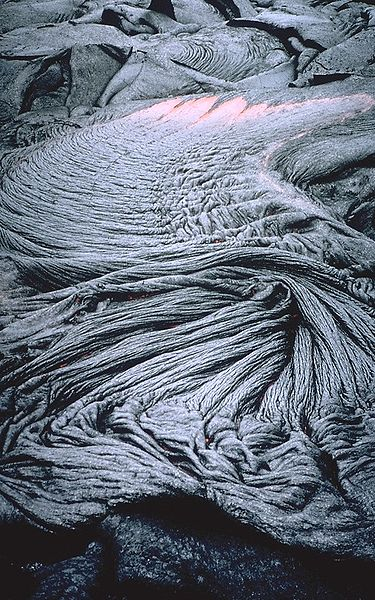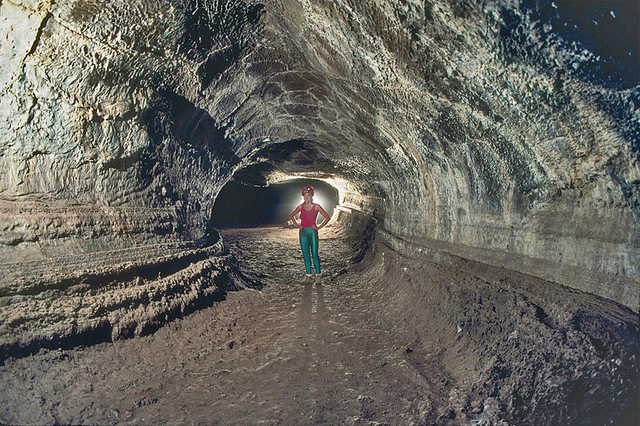Though the vast majority of caves around the world are formed out of limestone being eroded by water, there are exceptions. One of the most common of these are lava tubes.

Thurston Lava Lube, Big Island, Hawaii [Image source]
Lava tubes are exactly what they sound like- tubes that magma ran through. More accurately, however, they're tubes made out of lava that more magma ran through. They generally form only in basaltic lava. This is because basaltic lava is one of the least viscous magmas- it can flow as quickly as sixty miles per hour, though it usually flows considerably slower than that. It usually has the approximate viscosity of ketchup. It's basically the classic movie magma.
It can't just be any basaltic magma, however- there are a couple of different kinds. Pahoehoe is the one that most readily forms lava tubes. Its name translates to "smooth unbroken lava" in Hawaiian. Pahoehoe is by far the most fluid type of basalt, and typically hardens into ropy, smooth, and undulating surfaces. Its fluidity allows it to keep flowing beneath a hardened crust. The other major type of basalt is a'a, which hardens into a jagged, shoe-cutting broken mass. Its name translates into "stony rough lava", though the running joke among geologists is that it is named after the sounds you make while walking on it.

Pahoehoe lava [Image source]
The formation of lava tubes occurs when the magma starts to harden. Basalt can, if it is in thick enough layers, cool very, very slowly. A lava lake might take weeks or even months to cool. When there is a current in the magma, it can still flow underneath the crust as it hardens at the top of the lava. As the magma flows through channels, the sides of the channels begins to harden, and the crust can form above it.
Alternatively, pahoehoe flows can block their source. When this happens, pressure builds until the source breaks out again. The passage between the original source and the breakout point takes the form of a lava tube.

Valentine Cave, a lava tube found in Lava Beds National Monument, California. [Image source
Lava tubes have a lot of speleothems- cave formations- unique to them. If you look at the photos of the lava tubes in the pictures, you might notice straight horizontal lines running along the sides of the tubes. These are step marks, and they indicate a place where the magma flowed for some time at a steady level. The tubes start completely full, and slowly drain.

A skylight looking down into a still active lava tube. [Image source
Lavacicles are another common lava tube speleothem. Essentially, they occur when lava starts to drip or stretch down from the ceiling of the lava tube. They come in three main types. Shark tooth lavacicles form from small driblets on the ceiling that accrete in layers from lava levels rising and falling in the channel. Splash lavacicles form from lava being splashed on the ceiling and then dripping down, which gives it a stretched taffy look. They also sometimes have a different color and composition than the ceiling rock. The third type is the tubular lavacicle. These form when the roof still has molten material in it. Trapped gases trying to escape blow out magma into a tubular structure up to two meters long, in a process that vaguely resembles glass blowing.

Shark tooth lavacicles.[Image source]
Lava pillars are another cave speleothem. These hollow pillars are formed in the gaps between lava flows. Water trapped inside causes the walls of the lava to harden as they close around it, leaving an open vertical tube. These tubes often act as conduits for hydrothermal gases for years after the surrounding lava hardens.

Lava pillar in Korea. [Image source]
Lava tubes aren't just found on Earth. They've also been found on Mars and the Moon. Due to the moon's low gravity, lunar lava tubes might reach as far across as half a kilometer (1600 feet). They'd actually make excellent locations for moon bases- they would provide shielding from micrometeor bombardment, radiation, and solar flares.
While Martian lava tubes don't reach the enormous sizes of lunar ones, they're still much larger than the lava tubes on Earth. We've detected some as wide as 200 meters across. They still might make decent possibilities for building bases, but they have another, even more interesting feature- some scientists think that if life ever did exist on Mars, remnants of it might have survived in the lava tubes longer than on the surface. And maybe, just maybe, some chemosynthetic bacteria or other primitive life might still be living in them, living off the volcanic minerals present in the tubes.
Lava tubes are also likely on Venus and Io, but people aren't going to be spending time on either of those hostile worlds anytime soon.

A largely collapsed lunar lava tube. [Image source]
Lava tubes hold a special place in my heart. The first cave I ever visited, Ape Cave, is a lava tube. Ape Cave, located south of Mount Saint Helens, is the longest lava tube in the continental United States and the third longest in North America. It's 4,023 meters long. (2.5 miles). It's also the cave I've spent the most time in by far- I've hiked the whole thing at least three or four different times. If you're ever in the Pacific Northwest, I highly recommend you check it out!

It's me below a skylight in Ape Cave! Sorry for the terrible picture quality, my phone camera hates taking photos in the dark, and the flash barely helps.
Bibliography:
https://en.wikipedia.org/wiki/Lava_tube
https://en.wikipedia.org/wiki/Martian_lava_tube
https://en.wikipedia.org/wiki/Lunar_lava_tube
https://en.wikipedia.org/wiki/Lava_pillars
https://en.wikipedia.org/wiki/Stalactite
https://en.wikipedia.org/wiki/Lava
http://lewisriver.com/apecave.html
Hooray for some Pacific NW love at the end! I haven't had the pleasure of exploring that cave, but it's cool that you brought it to my attention. Now that I'm in Alaska, and there are a lot of active volcanoes, you've got me wondering if there are any lava tubes up here. However, I think there are different types of volcanoes, and these are less lava-ish and more just-go-boom-ish. Forgive my juvenile geological language. Haha.
Downvoting a post can decrease pending rewards and make it less visible. Common reasons:
Submit
Haha, I've heard plenty of geologists talk pretty much like that! I'm pretty sure there are some lava tubes in Alaska, though I can't remember where off hand.
Downvoting a post can decrease pending rewards and make it less visible. Common reasons:
Submit
This is an amazing article, @mountainwashere! I learned so many new things. I live fairly close to Ape Cave, and never even knew it was there. I'm going to have to see about visiting it someday.
I have upvoted and resteemed this post. I found the link to this article on #unmentionables.
Keep up the great work with these fascinating articles.
Cheers!
@mitneb
Downvoting a post can decrease pending rewards and make it less visible. Common reasons:
Submit
You definitely should visit it! Be sure to bring jackets and headlamps, though flashlights can work.
Downvoting a post can decrease pending rewards and make it less visible. Common reasons:
Submit
Ok, @mountainwashere! Thanks for the advice!
Cheers!
@mitneb
Downvoting a post can decrease pending rewards and make it less visible. Common reasons:
Submit
Hey, very interesting article :) I got to explore some lava tubes in the Galápagos a while back and found them utterly fascinating. I didn't even think about the possibility of finding these on the moon or Mars though! Do you reckon they'd be able to build decent bases in them? I mean it makes good sense to use pre-existing structures if they're there right? I'd imagine they're also pretty stable... Hmm, are there Mars-quakes?
Downvoting a post can decrease pending rewards and make it less visible. Common reasons:
Submit
Yeah, they're pretty stable, and though there are moon and Mars quakes, they're not as bad as earthquakes. Also, your post reminded me to add a couple tidbits into the space section of the article!
Downvoting a post can decrease pending rewards and make it less visible. Common reasons:
Submit
Great post I want to go and find a lava tube. Shame there are none in England :(
Downvoting a post can decrease pending rewards and make it less visible. Common reasons:
Submit
There's not much I could find in the UK- however, one of the longest lava tubes in the world is on Tenerife, in the Canary Islands.
Downvoting a post can decrease pending rewards and make it less visible. Common reasons:
Submit
I'll add to the growing list of places to visit. Great post fascinating to see!
Downvoting a post can decrease pending rewards and make it less visible. Common reasons:
Submit
What an interesting post, loving the mention of moon's lava tubes. I think there is much potential there in setting up future moonbases. I do wonder how we were able to detect how big those lava tubes are on the moon though.
Downvoting a post can decrease pending rewards and make it less visible. Common reasons:
Submit
Well, if you look at the photo of the collapsed lunar tunnel, we know how wide that is. We have some other photos as well.
Downvoting a post can decrease pending rewards and make it less visible. Common reasons:
Submit
Gosh, do u go on these adventures often? Love how the lava pillars are formed.
Downvoting a post can decrease pending rewards and make it less visible. Common reasons:
Submit
Not as often as I'd like!
Downvoting a post can decrease pending rewards and make it less visible. Common reasons:
Submit
Such an awesome post lava caves are such an amazing phenomenon
Downvoting a post can decrease pending rewards and make it less visible. Common reasons:
Submit
They are, yeah!
Downvoting a post can decrease pending rewards and make it less visible. Common reasons:
Submit
Congratulations @mountainwashere! You have completed some achievement on Steemit and have been rewarded with new badge(s) :
Click on any badge to view your own Board of Honor on SteemitBoard.
For more information about SteemitBoard, click here
If you no longer want to receive notifications, reply to this comment with the word
STOPDownvoting a post can decrease pending rewards and make it less visible. Common reasons:
Submit
omg, Brother very interesting article
Downvoting a post can decrease pending rewards and make it less visible. Common reasons:
Submit
Thanks!
Downvoting a post can decrease pending rewards and make it less visible. Common reasons:
Submit
@originalworks
Downvoting a post can decrease pending rewards and make it less visible. Common reasons:
Submit
The @OriginalWorks bot has determined this post by @mountainwashere to be original material and upvoted it!
To call @OriginalWorks, simply reply to any post with @originalworks or !originalworks in your message!
Downvoting a post can decrease pending rewards and make it less visible. Common reasons:
Submit
Amazing one :)
Very informative post..Glad to know more :)
Downvoting a post can decrease pending rewards and make it less visible. Common reasons:
Submit
Your Post Has Been Featured on @Resteemable!
Feature any Steemit post using resteemit.com!
How It Works:
1. Take Any Steemit URL
2. Erase
https://3. Type
reGet Featured Instantly – Featured Posts are voted every 2.4hrs
Join the Curation Team Here
Downvoting a post can decrease pending rewards and make it less visible. Common reasons:
Submit
Downvoting a post can decrease pending rewards and make it less visible. Common reasons:
Submit
you are right bro
Downvoting a post can decrease pending rewards and make it less visible. Common reasons:
Submit
Right about what? Maybe it wasn't intended about such, but this comment feels a little like spam. In order to help keep it from doing so, maybe consider commenting in a little more detail about the subject matter.
Downvoting a post can decrease pending rewards and make it less visible. Common reasons:
Submit